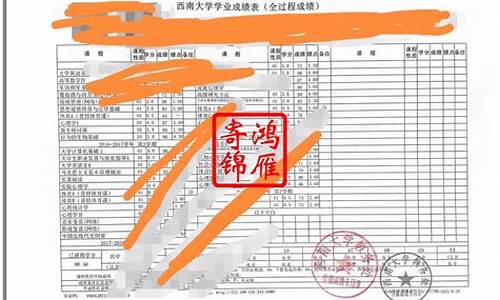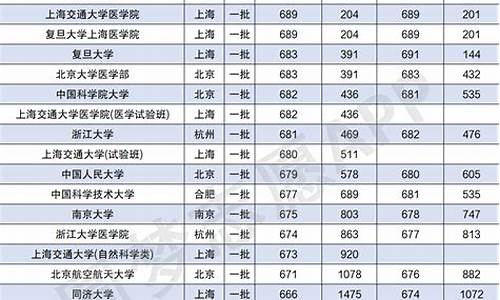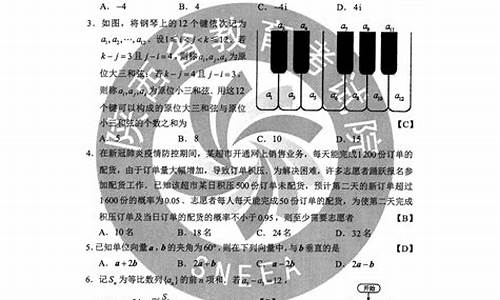您现在的位置是: 首页 > 分数线 分数线
英语高考时态,英语高考时态考几种
tamoadmin 2024-05-25 人已围观
简介1.急求“高中英语语法时态(过去、现在、将来)的结构、用法及练习题,能提供历年高考相关的题更好!!!2.高考英语作文时态3.2018年高考英语必须掌握的十六种时态变化用法你好,是10种1. 一般现在时2. 现在进行时3. 现在完成时4.现在完成进行时5.一般过去时6. 过去进行时7.过去完成时8.一般将来时9.将来进行时10.将来完成时急求“高中英语语法时态(过去、现在、将来)的结构、用法及练习题
1.急求“高中英语语法时态(过去、现在、将来)的结构、用法及练习题,能提供历年高考相关的题更好!!!
2.高考英语作文时态
3.2018年高考英语必须掌握的十六种时态变化用法

你好,是10种
1. 一般现在时
2. 现在进行时
3. 现在完成时
4.现在完成进行时
5.一般过去时
6. 过去进行时
7.过去完成时
8.一般将来时
9.将来进行时
10.将来完成时
急求“高中英语语法时态(过去、现在、将来)的结构、用法及练习题,能提供历年高考相关的题更好!!!
谓语动词的时态(一)
作谓语动词用来表示动作(情况)发生时间的各种形式称为时态。英语中不同时间发生的动作,要用不同形式的动词来表示。因此,每说一句话都要考虑时态问题,谓语动词要用适当的时态形式。
英语一共有十六个时态。
一般现在时、 现在进行时、 现在完成时、 现在完成进行时、 一般过去时、 过去进行时、 过去完成时、 过去完成进行时、 一般将来时 、将来进行时 、将来完成时、 将来完成进行时、 一般过去将来时、 过去将来进行时 、过去将来完成时、 过去将来完成进行时
但是,英语中常用的时态有五个:一般现在时,现在进行时,一般过去时,一般将来时和现在完成时。还有些时态用得也比较多一些,如:过去进行时,过去完成时,过去将来时,现在完成进行时等,其它时态用得比较少,有的时态甚至很少用到。
英语时态形式可以用下表来表示:(以study为例)
一般时态、进行时态、完成时态、完成进行时态、
现 在study studies、is/ am/ are studying 、has/ have studied、has/ have been studying
过 去studied、was/ were studying 、had studied、had been studying、
将 来shall/ will study、shall/ will be studying、shall/ will have studied、shall/ will have been studying
过 去 将 来should/ would study、should/ would be studying、should/ would have studied、should/ would have been studying、
在这里,我们重点讲一下以下常用时态:
一、一般现在时
一般现在时主要用来表示:
1. 表示一种永久性的、不涉及特定的时间的一般性陈述和客观存在。
e.g. I) He smokes too much.
II) It seldom snows here.
2. 用于说明自然规律、客观真理、科学事实,格言、谚语等也属于词类等。
e.g. I) The earth moves round the sun.
II) Actions speak louder than words. 行动胜于雄辩。
3. 动作动词的一般现在时可以表示现阶段重复发生的一系列事件。这时常和sometimes, often, usually, frequently, every day/week/month/year, daily, monthly, once a year, twice a day, five times a month等表示频度的副词(短语)连用。
e.g. I) Teenagers often spend hours shopping, especially on weekends.
II) We always care for each other and care for each other.
4. 如果动作动词所指的是一个在讲话时开始并结束的单一行为,则意味着该事件很少或没有持续性,通常只用于行为语、特殊感叹句或对快速体育运动等的实况报导。
e.g. I) Here comes the winner.
II) I declare the meeting open. 我宣布会议开始。
5. 表示将来时间。在由when,if,after,before,as soon as,even if,in case,though,till,until,unless,so long as等引导的时间状语从句或条件状语从句中,一般现在时可以用来表示将来时间。
e.g. I) You’d better take an umbrella in case (万一) it rains.
II) So long as (只要) you work hard, you’ll surely succeed.
6. 一般现在时可以用来表示一个按规定、计划、或安排要发生的情况。但这只限于少数动词,如begin, come, go, leave, sail, start, arrive, return, end, stop, depart, open, close等。
e.g. I) The plane takes off at 11 a.m.
II) School begins the day after tomorrow.
III) Is there a film on tonight?
7. 在I hope, I bet等后面的that-分句中可用一般现在时表示将来概念。
e.g. I) I bet Houston Rocket beats Miami Heats this afternoon.
II) I hope the storm passes quickly.
8. 在see (to it), make sure, make certain等后面的that-分句中可用一般现在时表示将来概念。
e.g. I) Please see (to it) that windows are closed before you leave.
II) Be sure that you don’t work too hard.
9. 用于讲故事,叙述文、新闻报导或说明等中,以增加描述的生动性和真实感。
e.g. He sits down, shivers (颤抖) a little. The clock outside strikes twelve.
二、一般将来时
一般将来时主要用来表示:
1. 将要发生的动作或情况。
e.g. I) When shall we have an oral test (口试)?
II) He will start to work in June.
2. 习惯动作或未来的倾向。
e.g. I) Wherever he goes, he will take an umbrella with him.
II) Only in this way will we succeed. 只有这样我们才能成功。
3. 表示将要发生的动作,除了一般将来时外,还有一些其他结构和时态。
a) be going + 不定式 (表示打算、准备做的事或即将发生或肯定要发生的事)
e.g. I) Look at those clouds! It’s going to rain. 看那些乌云,天快下雨了。
II) I am going to leave for Paris with my classmates next week.
b) be about + 不定式 (表示正要、刚要发生的事情)
e.g. I) The train is about to leave.
II) We are just in time. The curtain is about to go up. 我们来得很及时,**刚好拉开序幕。
c) be + 不定式 (表示按日程将要发生的动作)
e.g. I) There is to be a test in the fifth week.
II) I am to meet my friend at the railway station this afternoon.
d) 动词现在时 (见现在进行时2)
e) 一般现在时 (见一般现在时5、6、7、8)
f) 动词将来进行时,可用来表示不含意图的将来概念。
e.g. I) Machines will be doing many jobs that people do today.
II) We will be staying in Beijing for three days.
三、一般过去时
一般过去时主要用来表示:
1. 表示事件或状态必定发生在过去,从其完成到现在之间有一段间隔。过去时间可以由状语表示,如yesterday,an hour ago,in 1972,last year等。
e.g. I) In 1972, Father’s Day became a national holiday in the United States.
II) Jane was here a moment ago.
2. 动作动词的一般过去时可以表示在过去一段时间里重复发生的一系列事件。这时常和sometimes, often, usually, frequently, every day/week/month/year, daily, monthly, once a year, twice a day, five times a month等表示频度的副词(短语)连用。
e.g. I) Ken never smoked.
II) I went to the cinema three times last week.
3. 在时间和条件状语从句中,一般过去时可以替代过去将来时。
e.g. I) Father promised to buy me a MP3 if he got a pay raise.
II) I couldn’t watch that exciting game before my homework was finished.
四、现在完成时
1. 现在完成时只要用来表示:
a) 开始于过去而延续至今的动作(有可能继续延续下去)或重复性的事件。
e.g. I) Advertising has become a very specialized activity in modern times. 广告在现代社会中已成为一项非常专业化的活动。
II) She has lived here since 1997.
b) 动作的结果到现在时刻仍然存在,常与recently, just, already, yet, before, in the past few years, up to now, so far, this year, for, since等时间状语连用。
e.g. I) So far we have learned a lot about different tenses.
II) In the past few decades (十年) great changes have taken place in Hangzhou.
2. 现在完成时和一般过去时的比较:
a) 意义上的区别
两种时态的动作都发生在过去,现在完成时强调动作现在的结果;过去时着眼过去的动作或状态本身。试比较:
e.g. I) I have read this book. (说明我了解书的内容。)
II) I read this book yesterday. (叙述昨天做的一件事,与现在无关。)
b) 时间状语的区别
与一般过去时相关的状语yesterday (morning), a month ago, earlier this month, last week/month/year/ Monday, the other day (前几天), at that time, in 1979, etc.与现在完成时相关的状语since Monday, so far, ever, never, up to now/ present, yet, for three days, etc.与两者都相关的状语Today, recently, this week/month/year/June, this morning/afternoon/evening, recently, before, once, already, etc.
c) 特殊用法
i) 在“This/ It is the first (second, third, last, etc.) time …”后用现在完成时。
e.g. It is the first time that I have traveled by train.
ii) 在“It is/ has been a long time since …”后用过去时。
e.g. It has been 10 years since I graduated from my university.
iii) 在“This is + 最高级形容词 + 名词”后的从句中用现在完成时。
e.g. He is the most interesting person I have ever met.
五、将来完成时
将来完成时由shall (will) have加过去分词构成,主要表示将来某时已经发生的事情。如果句子中有“by + 将来的某一时间”或when, before等时间状语时,可以用将来完成时。
e.g. I) I shall have finished my homework before lunch.
II) By the end of next month, he will have lived here fore three years.
III) When we get there, they will probably have left.
IV) Hurry up, or the train will have left by the time we get to the station.
六、过去完成时
1. 过去完成时的用法
过去完成时主要表示先于过去某一时间的事件或状态,即“过去的过去”。这一事件或状态可以在过去某一时间以前已经完成,也可能从“过去的过去”某一时间一直延续到过去某一时间(甚至还可能延续下去,但与现在时间无关)。
a) 过去完成时常和after, before, by, till, when, until等引入的状语连用。
e.g. I) I began collecting stamps in February and by November I had collected more than 2000.
II) When I woke up it had already stopped raining.
III) She didn’t go to bed until she had finished her homework.
b) 在很多情况下没有明显的时间状语,时间由上下文表示出来。
e.g.I) He went to see his boss and told him what had happened.
II) They returned earlier than we had expected.
c) 过去完成时的几种特殊用法
i) 和before连用,表示“还没……就”。
e.g. I) She cried before I had realized what was happening. 我还没有意识到发生什么事情她就哭了起来。
II) They set out before I had told them the address.
ii) “It/This/That was the first/second/third time that …” 结构中的从句,要求用过去完成时态。
e.g. I) It was the first time they had tried foreign food.
II) It was the first time that he had finished his composition in 30 minutes.
iii) 在“no sooner … than …”和“hardly/scarcely … when …”的结构中,主句中用过去完成时,从句中用一般过去时。
e.g. I) I had hardly closed my eyes when the telephone rang.
II) No sooner had we begun than we were told to stop.
iv) 与expect, hope, intend, mean, plan, suppose, think, want等动词连用时,表示过去的希望、预期、意图或愿望等没有实现。
e.g. I) I had planned to visit you, but I just couldn’t find time.
II) He had hoped to help you, but he was ill.
2. 过去完成时和一般过去时的比较:
过去完成时表示过去某一时刻,或某个动作前发生的事,即过去的过去,它着眼于显示过去发生的几个动作的先后。一般过去时只叙述过去某时刻或某时刻后发生的动作,但不强调时间顺序。
e.g. I) When he got home, his wife had already prepared the dinner. (他回家前饭已做好。)
II) When he got home, he saw a letter on his desk. (他回家后看到桌上有一封信。)
七、现在进行时
现在进行时主要用来表示:
1. 现在或现在这一阶段正在进行的动作。
e.g. I) They are making preparations for it.
II) He is showing a foreign guest round the city.
2. 一个在最近按计划或安排要进行的动作。但这只限于少数动词,如go, come, leave, start, arrive, return, work, sleep, stay, do, play等。
e.g. I) We are leaving on Friday.
II) I am seeing the doctor today.
3. 有时用来代替一般现在时,表示一个经常性动作或状态,通常是为了表示一种感情(如赞叹、厌烦等)。
e.g. I) He is constantly complaining about his teacher. 他老是抱怨他的老师。
II) How are you feeling today?
III) He is always boasting. 他老爱说大话。
be间或可以用在进行时态,表示一时的表现。
e.g. I) The boy is being difficult. 这男孩正在闹别扭。(可能他平时很听话的。)
II) Frank is being a good boy today. 弗兰克今天很乖。(可能他平时并不乖。)
八、过去进行时
过去进行体和现在进行体的用法相仿,只是时间向过去推移而已。过去进行时表示过去某时或某断时期正在进行的动作。
e.g. I) What were you doing when I called?
II) What were you doing last night at 10 o’clock?
九、将来进行时
将来进行时表示将来某时或某时期正在进行的动作。
e.g. I) I don’t know what my wife will be doing when I return home.
II) When I prepare for the college entrance examination (高考), my sister will be taking her vacation (度假) at the seaside.
十、现在完成进行时
现在完成进行时可以用来表示:
1. 表示现在某时刻之前一直在进行着的动作,这个动作可能已经完成,也可能仍在进行。
e.g. I) How long has it been raining?
II) I have been working on my paper for five years.
2. 有些延续动词如live, study, teach, work等的现在完成时与现在完成进行时的区别不大,都表示延续一段时间的动作,现在完成时更强调动作的延续性。
e.g. I) I have lived here for ten years. = I have been living here for ten years.
II) How long have you taught English here? = How long have you been teaching English here?
但是,多数延续性动词的现在完成时与现在完成进行时表达的意义有所不同。
e.g. He has been writing this morning and has written four letters.
十一、过去完成进行时
过去完成进行时的主要用法与现在完成进行时的用法相仿,只是时间推移到了过去。
e.g. I) They had been waiting for half an hour before the bus came.
II) The fire had been burning for over a week.
十二、将来完成进行时
将来完成进行时将来某时刻前一直进行的动作。
e.g. I) By next year he will have been teaching English for 30 years.
II) In an hour you will have been surfing the net (上网) for 5 hours today.
高考英语作文时态
讲解和题目都有了,只是题目太长,经济年度高考题也有好几十条,粘不上来,要觉得好就给你邮箱
语法专项复习四:动词的时态和语态
动词的时态
时态是谓语动词所表示的动作或情况发生时间的各种形式。英语动词有16种时态,但是常见的只有九种:一般现在时、一般过去时、一般将来时、现在进行时、过去进行时、现在完成时、过去完成时、过去将来时、现在完成进行时。
(一)一般现在时
1. 表示经常性或习惯性动作 We always care for each other and help each other.
2. 表示现在的特征或状态 He is very happy.
3. 表示普遍真理 Light travels faster than sound. 光速比声速快。
(二)一般过去时
1. 表示过去某一特定时间所发生的、可完成的动作或状态,常与表示确切过去时间的词、短语或从句连用。例如: We went to the pictures last night and saw a very interesting film.
2. 表示过去习惯性动作。例如: I used to do my homework in the library.
(三)一般将来时
1. 表示将来打算进行或期待发生的动作或状态。例如:
I will/shall graduate next year.
2. 一般将来时有时可以表示一种倾向或习惯性动作。如:
Crops will die without water.
You won’t succeed without their support.
3. 几种替代形式:
(1) be going to+动词原形结构的用法
这种结构表示主体现在的意图,即打算在最近或将来要做某事。例如:
What are you going to do next Sunday? 下星期天你打算干什么?
此外, 这种结构也可表示说话人根据已有的迹象认为很可能即将发生某事。这时主语既可指人也可指物,此结构往往表示客观事态的发展,而不是表示主观的意图。例如:
Look at these black clouds. —It’s going to rain. 看这些乌云。天快要下雨了。
I’m afraid I’m going to have a bad cold. 恐怕我要得重感冒。
注:be going to与will用法上的异同及比较说明:
① be going to与will都可用来表示即将发生的事情。前者多用于口语,后者常用于书面语和正式文告中。例如:
There’ll (=is going to) be a football match in our school next week.
下周我校将举行(有)一场足球赛。
② be going to 与will都可用来表示意图。例如:
I will (=am going to) climb the hill tomorrow. 我将于明天去登山。
注:一般来说,“意图”是事先经过考虑的,用be going to表示;反之则用will。will还多用于对话中,即一方听了对方的话后所作出的反应。例如:
They’re going to meet at the school gate. 他们打算在学校大门见面。
—- Please bring me a cup of tea. 请给我端杯茶来。
—I’ll do it in a minute. 我马上就去(端)。
③ be going to常含有“即将”之意;而will即可表示“即将”又可表示“较长时间后的未来”,或不表示任何特定的将来时间概念。例如:
We’re going to visit the factory. 我们即将去参观那家工厂。
He’ll write a book one day. 他有朝一日要写书。
The house will break down. 那屋子(迟早)要倒塌。
④ 表示预测:be going to表示有发生某事的迹象;will则表示说话者认为要发生某事。如:
It’s very dark and cold. It’s going to snow. 天很暗而且非常冷,要下雪了。
I’m sure he’ll be back in an hour. 我确信他一小时后会回来。
⑤ 在表示“询问对方是否愿意”以及表示“客气的邀请”时,常用will。例如:
Will you lend me the book? 你能把那本书借给我吗?
⑥ be going to可用于条件句,表示将来的时间,will一般不能。例如:
If you are going to watch TV this evening, you’d better finish your homework now.
你若想今晚看电视,最好现在就完成作业。
⑦ 如果条件从句表示将来发生的动作或状态,主句中常用will,而条件从句中则用一般现在时表示。例如:
If you go to England, you will like the food there. 如果你去英国,你会喜欢那儿的食物的。
(2) be+动词不定式结构的用法
这种结构着重指按计划或安排将要发生某事。常表示“职责、意图、约定、可能性”等。如:
You are to be back by 11 o’clock. 你必须11点回来。
We are to meet at the zoo. 我们约定在动物园见面。
The football match is not to be played today. 今天不能举行足球比赛了。
(3) be about+动词不定式结构的用法
这种结构表示“最近或马上要发生的动作”, 不与具体时间状语连用。例如:
I was about to leave when Mary came. 我正要走时, 玛丽来了。
(4) be+v.-ing结构的用法
这种结构表示按计划即将发生的动作,用进行时形式表示将来的时间,但只适用于表示位置移动的动词。例如:go, come, leave, start, arrive, move, return, fly (乘飞机)等,并常伴有表示将来时间的状语以区别于进行时的动作。例如:
Where are you going this Saturday? 这个星期六你准备去哪儿?
Mr. Li is flying to Shanghai tomorrow morning. 李先生明天早晨乘飞机去上海。
(5) 用一般现在时表示将来的时间的用法
这种用法除了动词be外,一般适用于表示位置转移的动词, 例如:go, come, leave, start, arrive, move, return, fly等,或表示根据规定或时间表上预计要发生的动作或事态。 此外,在由if, when, as soon as, until, till, after, before等引导的条件或时间状语从句中,若主句为将来时,从句通常用一般现在时表示将来的时间。例如:
I’m free this afternoon. 我今天下午有空。
School starts on September 1. 学校9月1日开学。
I’ll give the book to him as soon as he returns. 他一回来,我就把书给他。
(四)现在进行时
1. 表示现在某时或某段时间内正在进行的动作。
He is writing a letter now.
2. 有时用来代替一般现在时态,表示一个经常性动作或状态,这时是为了表示一种感情(如赞叹,厌烦,满意,不满等)。
He is always thinking of his work. (表示赞许)
The boy is always talking in class. (表示不满)
3. 有时用来表示一个在最近按计划或安排要进行的动作(这时多有一个表示未来的时间状语)。
How many of you are coming to the party?
(五)现在完成时
1. 现在完成时用来表示对目前状况仍有影响的,刚刚完成的动作(常与yet,already,just连用),或者过去某一时刻发生的,持续到现在的情况(常与for,since连用)。例如:
I have just finished my homework.
Mary has been ill for three days.
2. 完成时态可用在下列结构中:
(1) This (That, It) is (was) the first (second...) time +定语从句;
(2) This (That, It) is (was) the only (last) + n +定语从句;
(3) This (That, It) is (was) +形容词最高级+ n +定语从句。
如果主句的谓语动词是一般现在时,从句的谓语动词通常用现在完成时;如果主句谓语动词是一般过去时,从句谓语动词通常用过去完成时。例如:
This is one of the rarest questions that have ever been raised at such a meeting.
There was a knock at the door. It was the second time someone had interrupted me that evening.
(六)过去进行时
过去进行时表示一个过去的动作发生时或发生后,另一个过去的动作正在进行,或表示过去反复的习惯,常与always,continually,constantly等动词连用。例如:
We were discussing the matter when the headmaster entered.
Whenever I visited him, he was always writing at the desk.
(七)过去完成时
1. 表示过去某时间前已经发生的动作或情况,这个过去的时间可以用by,before等介词短语或一个时间状语从句来表示;或者表示一个动作在另一个过去动作之前已经完成。例如:
We had just had our breakfast when Tom came in.
By the end of last year they had turned out 5, 000 bicycles.
2. 动词expect, hope, mean, intend, plan, suppose, wish, want, desire等用过去完成时,表示过去的希望、预期、意图或愿望等没有实现。例如:
I had meant to take a good holiday this year, but I wasn't able to get away.
另外两种表示"过去想做而未做的事"的表达方式是:
(1) was / were + to have done sth. 例如:
We were to have come yesterday, but we couldn't.
(2) intended/expected/hope/meant/planned/supposed/wished/wanted/desired+ to have done sth. 如:
I meant to have told you about it, but I forgot to do so.
3. 过去完成时常用于以下固定句型:
① hardly, scarcely, barely +过去完成时+ when +过去时。例如:
Hardly had I got on the bus when it started to move.
② no sooner +过去完成时+ than +过去时。例如:
No sooner had I gone out than he came to see me.
③ by (the end of ) +过去时间,主句中谓语动词用过去完成时。例如:
The experiment had been finished by 4 o'clock yesterday afternoon.
(八) 一般过去将来时
1. 一般过去将来时的形式
should / would+ 动词原形 或 was / were + 动词-ing形式
2. 一般过去将来时常用于宾语从句中,其主语的谓语动词为过去时态,可表示从过去某时看来将要发生的事情,如:
He said that he would speak at the meeting.
He was sixty-eight. In two years he would be seventy.
(九)现在完成进行时
现在完成进行时表示动作从过去某一时刻开始一直延续到现在或离现在不远时候。现在完成进行时所用动词均为延续性动词。例如:
I have been looking for my lost book for three days, but I still haven't found it.
注意:运用动词时态要注意的几个问题
1. 在时间和条件等状语从句中不要用将来时态,如:
We’ll give him the book if he wants it.
He decided to fight back if he was hit again.
I’ll call you as soon as I’ve finished my work.
2. 时态的一致(时态的呼应),如
We saw that the smoke was coming from a window.
I didn’t know if she would come.
He admitted that he had been on the march.
*不进行时态调整的情况:
(1) 从句说的是一种普遍真理,如:
Long ago, people didn’t know the earth moves round the sun.
(2) 当从句的谓语改成过去时可能造成误会,如
Did he say that the train leaves at 5:30?
3. 瞬间动词在完成时态中的使用,如:
误:I have received her letter for three months.
正:I received her letter three months ago.
正:It is three months since I received her letter.
4. 注意某些要求一定时态的句型
* was/ were doing sth. when …did sth.
I was reading a book when the bell rang.
* was/were about to do sth. when … did sth.
She was about to go out when it started to rain
* 表示做事做了第几次或共几次,要用完成时态,如:
It’s the first time I’ve seen her.
We have been there three times.
* It is / has been… since…
It is (has been) two weeks since I came here.
* hardly…when…
We had hardly got in the crops when it began to rain.
* no sooner…than…
No sooner had I come into the room than the door was closed.
2018年高考英语必须掌握的十六种时态变化用法
1.一篇文章可以用多种时态,比如记叙用过去时,议论用现在时.
如果第一段叙述过去的事情,用了过去时,第二段叙述现在的事情,用现在时.第三段再叙述过去,理论上说还是应该用过去时,不过考虑到是考场作文,老师可能会认为你时态混乱,因此文章最好不要用这种结构.
2.一般说,自己的议论都要用现在时,但要根据具体的语境.
高考英语动词方面的注意事项,我觉得,一定要保持各部分时态一致,结构清晰,不要有明显的单词拼写,语法错误,字体整齐工整,25分得20分应该no problem!
#高考# 导语时态(Tense)是表示行为、动作和状态在各种时间条件下的动词形式。因此,当我们说时态结构的时候,指的是相应时态下的动词形式。以下是 考 网为大家整理的《十六种时态变化用法》供您查阅。
英语时态分为16种:一般现在、一般过去、一般将来、过去将来时,以及这四者的进行时、完成时和完成进行时。
1.一般现在时 (do/does; is/am/are)
① 表示现在的情况、状态或特征。
例:He is a student.
他是一个学生。
② 表示经常性、习惯性动作。
例:He always helps others.
他总是帮助别人。
③ 客观事实和普遍真理。
例:The earth moves the sun.
地球绕着太阳转。
④ 表示一个按规定、计划或安排要发生的动作。
仅限于某些表示“来、去、动 、停、开始、结束、继续”等的动词,可以与表示未来时间的状语搭配使用 。
常见的用法是:飞机、火车、轮船、汽车等定期定点运行的交通方式。
例:The next train leaves at 3 o'clock this afternoon.
下一趟火车今天下午3点开车。
⑤ 在时间、条件和让步状语从句中经常用一般现在(有时也用现在完成时)表示将的来事情。(即:主将从现原则)
例:I will call you as soon as I arrive at the airport.
我一到机场就会给你打电话。
When you have finished the report, I will have waited for about 3 hours.
等你完成这份报告的时候,我就已经等了将近3个小时了。
2. 现在进行时(am/is/are doing)
① 表示此时此刻正在发生的事情。
例:He is listning to the music now.
他现在正在听音乐。
② 表示目前一段时间内一直在做的事情,但不一定此时此刻正在做。
例:I am studying computer this term.
这个学期我一直在学习计算机。
③ 现在进行时可以表示将来的含义。
a. 瞬时动词的进行一定表将来。
例: I am leaving.
我要离开了。
b. 持续动词的进行只有有将来的时间状语或有将来语境中才表将来。
例: I am travelling next month.
下个月我要去旅行。
④ 现在进行时与频度副词连用,表示说话者或褒义或贬义的感情 色彩。
例: He is always helping others.
他总是帮助别人。(褒义)
3. 现在完成时(have/has done)
① 表示动作到现在为止已经完成或刚刚完成,强调对现在产生的影响。
例:I bought a new house, but I haven't sold my old one yet, so at the moment I have two houses.
我买了一所新房子,但是还没有卖掉旧的,所以现在我又两所房子。
② 表示从过去某时刻开始,持续到现在的动作或情况,并且有可能会继续延续下去。此时经常用延续性动词。
时间状语常用since加一个过去的时间点,或for加一段时间,或by加一个现在时间。
例:Great as Newton was, many of his ideas have been challenged today and are being modified by the work of scientists of our time.
虽然牛顿是个伟大的人物,但他的许多见解直到今天还在受到挑战,并且被现代科学家的工作所修正
4. 现在完成进行时(have/has been doing)
表示某一动作开始于过去某一时间,延续或重复地出现至今,或将继续延续至将来。
例:We have been working on this project for over a month now.
到目前为止,我们一直在处理那个项目,已经花了一个多月时间了。
5. 一般过去时 (did; was/were)
① 表示过去某个时间发生的动作或情况。
例:I bought some fruits yesterday.
我昨天买了一些水果。
② 表示过去习惯性动作。
例:When I was a boy,I often swam in that river.
would/used to do:表示过去常常......
例:The old man would sit on a bench in the quiet park and look at others for hours without doing anything or talking to anybody.
老人过去常常坐在宁静的公园里的一条长椅上,看着其他的人,一坐就是数个小时,什么也不干,也不和任何人交谈。
He used to visit his mother once a week.
他以前总是每周看望一次他的母亲。
6. 过去完成时(had done)
表示在过去的某个时间或动作以前已经发生的动作或已经存在的状态。就是我们常说的"过去的过去"。
Until then, his family hadn't heard from him for six months.
到那时为止,他家里已经有六个月没得到他的消息了。
7. 过去将来时(would do)
表示从过去的某个时间看将要发生的事。
例:I said on Thursday I should see my friend the next day.
我星期四说我将于第二天拜访我的朋友。
8. 过去进行时(was/ were doing)
① 表示在过去具体的时间正在发生的动作。
例:Mary was listening to light music 10 minutes ago.
10分钟前,玛丽正在听轻音乐。
② 表示过去某个时间段内一直在发生的事情。
例:I was travelling in London last summer vacation.
去年暑假我在伦敦旅行。
③ 过去进行时可以表示过去将来的含义。
a. 瞬时动词的过去进行时一定表示过去将来的含义。
例:Then she said she was leaving.
然后她说她要离开了。
b. 持续动词的过去进行时只有在有过去将来的时间状语或过去将来的语境下才能表示过去将来。
例:She said that she was travelling the next day.
她说她第二天要去旅行。
④ 过去进行时和频度副词连用可以表示说话者或褒义或贬义的感情 色彩。
9. 一般将来时
(1)will do
① 表示主语主观意愿的将来。
例:I will send her a glass hand-made craft as her birthday gift.
我将送给她一个玻璃的手工制品,作为给她的生日礼物。
② 表示客观将来。
例:Fish will die without water.
离开水,鱼会死。
③ 表示临时决定。
例:——Mary has been ill for a week.
——Oh,I didn't know. I will go and see her.
(2)am/is/are going to do
① 表示计划、打算做某事。
例:This is just what I am going to say.
这正是我想说的。
② 表示根据某种迹象看,很可能或即将发生的事情,表推测。
例:Look at the dark clouds in the sky. It's going to rain.
看天上的乌云,要下雨了。
(3)am/is/are about to do
表示“即将、正要”时,可用。强调近期内或马上要做的事。
例:Don't worry, I am about to make a close examination on you.
别担心,我马上就给你做一次仔细的检查。
(4)be to do
① 表示“按计划、安排即将发生某事或打算做某事”。
例:She is to be seen in the lab on Monday.
星期一你准会在实验室见到她。
② 该做或不该做的事情(语气上接近于should, must, ought to, have to),表示一种命令、规劝性语气。
例:You are to go to bed and keep quiet, kids. Our guests are arriving in less than 5 minutes.
10. 将来进行时(will be doing)
表示在将来的某个具体时间正在发生的动作或事情。
例:Don't worry, you won't miss her. She will be wearing a red T-shirt and a white skirt at that time.
别担心,你不会认不出她的。她到时会穿一件红色的T恤衫和一条白色的短裙。
11. 将来完成时(will have done)
表示从将来的某一时间开始、延续到另一个将来时间的动作或状态,或是在某个将来时间完成,但对其后的另一个将来时间有影响的动作或状态。就好象把现在完成时平移到时间轴的将来时时段一样。
例:The conference will have lasted a full week by the time it ends.
会议从开始到结束将持续整整一个星期。
12. 将来完成进行时:(will have been doing)
表示动作从某一时间开始一直延续到将来某一时间,是否继续下去,应视上下文而定。
例:By the end of next month, the project will have been being worked for 3 years.
到下个月底为止,这项工程就已经不停地进行了3年了。
13. 过去完成进行时:had been doing
表示某一动作一直延续到过去某一时间,是否继续下去,应视上下文而定。
例:The old clock had been being taken apart of and fixed up again for several times by my 10-year old son before I came back home.
我回到家之前,我10岁大的儿子已经把这个旧钟表拆卸并重新组装了好几回了。
14. 过去将来进行时:( would be doing )
表示就过去某一时间而言,将来某一时间或时间段正在进行的动作,主要用于从句中。
例:The government promised that a new highway would be being built next July.
政府说第二年7月将有一条新的高速公路正在修建。
15. 过去将来完成时:(would have done)
表示就过去某一时间而言,将来某一时间之前所完成的动作。常用在虚拟语气中,表示与过去事实相反。
例:I believed by the end of that year an advanced version of that software would have been developed, but I was wrong.
我坚信到那年年底为止,那个软件的新版本将被开发出来。但是我错了。
16. 过去将来完成进行时:(would have been doing)
表示就过去某一时间而言,将来某一时刻之前一直在进行的动作,是否继续下去,应视上下文而定。
例:They said that by the end of the following month, the project would have been being worked for 3 years.
他们说到第二个月底为止,这项工程就已经不停地进行了3年了。









